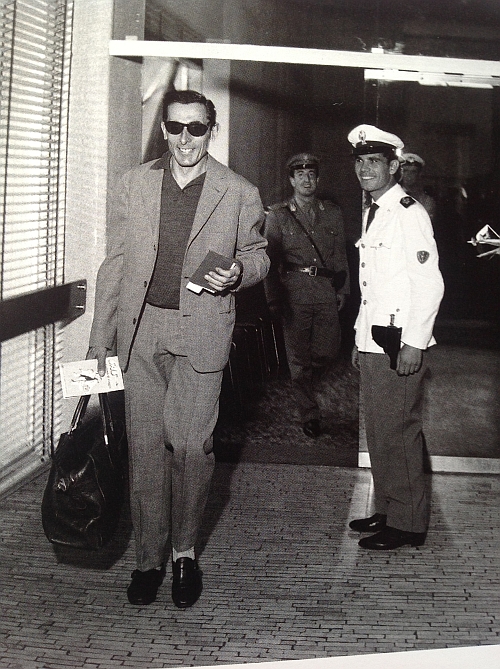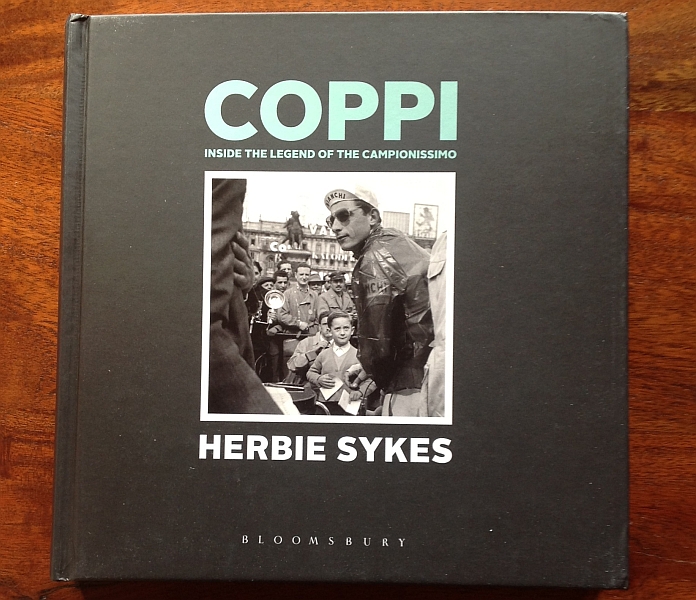Herbie Sykes promised never to write about Fausto Coppi. Visitors to Italy will find even village tobacconists sell magazines and books and these include often many cycling books, especially biographies of past Italian riders from the region. A resident of the Piemonte, the home of Coppi, Sykes had seen too many books about the man, a palimpsest of texts had obscured the past. But this is different.
This is a collection of photos accompanied by short accounts from 21 riders who were contemporaries of Coppi. The photography is excellent and surpasses the normal sports clichés. If there are one or two podium photos, there’s not one image of a victory salute.
It’s said Coppi was elegant on the bike but aloof of it with his gangly legs that earned him the nickname of Il Airone or “The Heron” because he could fly but standing still he was less gracious. But the books are full of glamour, Coppi sports dark glasses or wears a sharp suit and even amidst a rural hunting party his slick hair stands out. One picture of him looking at an Alfa Romeo reminded me of image from James Bond with its sophistication and luxury.

As many have remarked there’s a lot more going on in photos from the past compared to today’s images. Modern riders are hidden behind a mask of plastic helmets and glasses but the old days can show every facial expression. But Coppi never looks like he’s suffering and indeed if he’s in the middle of the frame often it’s the crowd or the scenery that is more revealing. There’s an image of Coppi climbing with Defilippis and the camera is behind, all you see of the riders is taught leg muscles and numbers on their backs. But the faces inside an official race car and roadside spectators show plenty. But most photos show Coppi when he’s not riding. At dinner, waiting for the start of the race, hunting, signing autographs, surrounded by crowds.
Italian reconstruction
At times it’s far more that Fausto Coppi and his peers. The pictures reveal plenty about Italy and would be useful for sociologists and historians looking to illustrate the rapid pace of change in Italy that occurred during Coppi’s career. Political, economic and cultural change was everywhere and you see it in the book. A peloton passes a railway being repaired or a giant new viaduct being built, building sites see Coppi signs hanging from ladders. Note the rise of the motorcar and the early consumer branding on jerseys and shorts. See how everyone wore suits on Sunday to watch a race back then.
Voices
The photos are great but what separates this from, say, the great Il Dolore photo blog is a structure and some text. First the photos go in order of his career and the 21 rider accounts are special. Each rider gives a personal account or anecdote and they don’t comment on the photos, instead they paint a picture of a moment from the past. Franco Franchi tells how he was a humble gregario tasked with fetching waterbottles. Pietro Nascimbene explains how he was a pro but earned little in the way of a salary, they relied on the team leader winning and then sharing the spoils. Ercole Baldini tells of rivalry with Coppi but like many, he doesn’t have many hard words to say and laments the media who tried to make a sporting rivalry into a greater animosity.
Golden Age?
This is pure nostalgia, a festival of the past. Sykes talks of cycling’s “golden age” and I’m not sure if the past was a better place, after all we learn of riders struggling to put food on the table and Coppi died because the study and understanding of tropical medicine was not what it is today.
Still, if the sport remains accessible today the images from the past show just how close people got to the riders and suggest they worshipped the champions, the crowds appear to be in communion. Today the public seems more indifferent and it’s hard to imagine a book in 50 years time with 300 pages of photos venerating Alberto Contador but that probably says more about Contador than anything else. Visually things were better and Coppi cuts a dash even when walking down the street in a suit. Today’s riders in branded team-issue leisurewear rarely look remarkable.
It’s heavy. At 1490 grams this book weighs as much as a pair of racing wheels. The weight isn’t normally associated with book reviews but it’s worth mentioning as this is a solid hardcover production with 320 pages which perhaps helps explain the price. Published in Britain by Rouleur, the book seems to be available in Europe for £24 or €30 and will be released in the US on March 1.
Summary
A collection of Fausto Coppi photos? Yes and the images are great alone. But for me the 21 accounts from Coppi’s contemporaries are what make the book special, voices that bring the past alive.
But this isn’t a book for the casual cyclist, I’d say it’s more for collectors and cognoscenti. If you can’t tell your Coppi from your Bartali yet you’d do well to read a biography of Coppi first to help put the images in context – for example William Fotheringham’s “Fallen Angel.” Still, if you just want to glimpse the rich history of Italian cycling and wow at the glamour then this should work too.
See for yourself with excerpts of book provided by the publisher at http://issuu.com.
A list of other book reviews is available here.
Note: this copy was sent for review



Stalone in the background of the bottom photo?
Nice review. I wish I could have hauled my copy over here to Italy but alas, I’ll have to wait to enjoy it next winter. I’ve just flipped through mine briefly as it arrived at xmas, but if Herbie’s done half the job he did with Maglia Rosa, this is a book I’ll treasure for a long time. I think the Golden Age refers more to the place cycling had in the public’s imagination vs other sports along with the outsized and colorful personalities so absent today when the riders are controlled so much in their comments and off-the-bike actions. We treasure our visits to Castellania each year, recreating some of that passion from days long gone.
Yes and yes: stunning photographs that capture the period and the oral histories are tremendously moving in their own right. I read this one evening just after Christmas and found it absolutely charming.
Re. the golden age: I think it has a great deal to do with the historical moment. The cyclists of the immediate post-WWII period captured the imaginations of sporting fans as a welcome diversion (keep in mind that cycling was until quite recently more popular than football in Italy). But I think the aesthetic you hint at is equally important: awkward off the bike, perhaps, but Coppi oozed style as you suggest in his suits and casual attire. Coppi, Koblet, Bobet were titans on the bike and gentlemen off it (or perceived as such anyway). The professional sport has changed dramatically, but a big part of the appeal of cycling remains that aesthetic that Coppi was instrumental in creating. Amateur riders will never ride like the pros, but we can always aspire to look like them…
+1.
I also received this book for Christmas; Velonista echoes my thoughts entirely.
“…and Coppi died because the study and understanding of tropical medicine was not what it is today.”
And the belligerence of the his Italian doctors who refused to believe their French counterparts treating Geminiani for the same symptoms.
I received this book for Christmas, though I’m yet to read it all, it is a beautiful thing.
I understand Geminiani got lucky. He fell ill and was taken to hospital near his home in central France but by chance the doctor had worked before in Africa and was able to make the diagnosis. A simple injection of quinine and he was cured.
I was under the impression that Geminiani’s doctors contacted Coppi’s but were ignored.
You’re still right, now they’d have known what was happening without advice.
“Palimpsest” – don’t say we never learn stuff on this site!
“It’s heavy. At 1490 grams this book weighs as much as a pair of racing wheels.”
Wonderful.
If I remember rightly it wasn’t to do with medical advances etc as chloroquinine was by then already being used to treat it, it may have been that malaria which had been endemic to much of Italy had been almost wiped out in Italy by 1960 and the doctor for some reason didn’t recognize the symptoms. If it had happened a few years earlier he probably would have!
“See how everyone wore suits on Sunday to watch a race back then.”
Back then, many men wore suits every day, not just on Sunday.
Fab review. Ahh, the glamour of mid-century Italy – what a contribution in design, decor and now we learn, cycling also. This period of time brought regency to the common man but in a restrained, more modest style. Wonderful!
I was also lucky enough to get this for Christmas; began flicking through it whilst waiting for my girlfriend to get ready but she ended up waiting for me – once you realise what a moving collection of photographs this truly is (not to mention the wonderful contributions from old team-mates), I defy anyone to rush through this book.